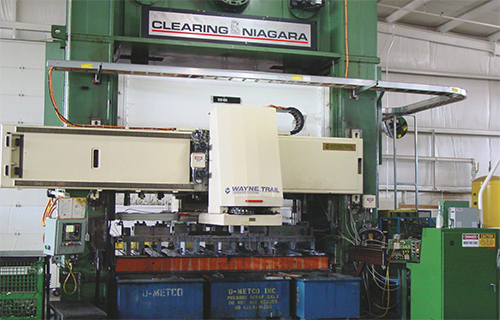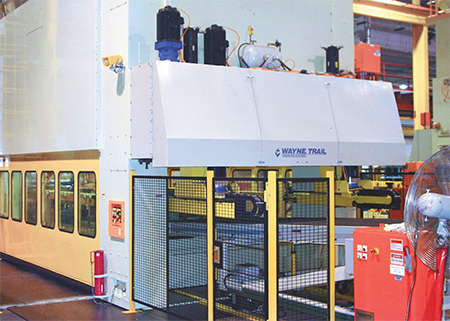To use a through-the-window transfer, the stamper would have to relocate the press feed, which increases the production footprint and could disrupt production workflow. Here, front-and-back transfers are a better solution—the module placement would not interfere with the press feed, keeping the current press-feed line intact.
Another factor: Based on the type of application, coil width can directly impact which servo-transfer solution to employ. With a front-and-back transfer, the modules take up far less real estate than an upright or through-the-window transfer. The tooling bar travels the length of the through-the-window press with the size of the tooling bar often dictated by the left-to-right dimension of the press, with a longer length requiring a larger tooling bar. This leaves reduced space for coil width. A lack of proper coil-width space reduces the range of automation capabilities on a press.
While both systems allow die access, a through-the-window transfer system is ideal if frequent access to the die is required. Transfer-drive mechanisms on both ends and the ability to uncouple the tooling bar ease access.
Front-and-back transfers are positioned in front of or behind the die so that the module can be run and parked in a full-up position for die access. However, when additional access is needed, longer transfer-mounting frames can be supplied, allowing the transfer module to be shifted laterally away from the press bed and parked in the offline position.
Systems Deliver Flexibility for Future Work
Full-servo through-the-window and modular front-and-back systems can provide stampers with the flexibility to address future production needs. Dual-lane production for each system eliminates the need for a second press and utilizes a smaller, more efficient footprint, which can double production output. The full-servo drive system allows for independent control of each axis, production of parts from the right or left side, and the ability to incorporate special tooling orientations or techniques.
Incorporating a U-turn configuration in the die line—possible in either type of system—also can eliminate the need for a second press. A U-turn arrangement allows for finger grips to transfer the part from station to station, and when a part reaches the end of the first production die line, the part is shifted 90 deg. and is transferred to the second production die line, which runs alongside the first. Since each tooling bar operates independently on the X axis, transfer bars move in opposite directions simultaneously, thus optimizing press loading and throughput.
Given the options in current servo-driven transfer technology, implementing a servo-transfer system into an existing press often is a cost-effective solution. MF
View Glossary of Metalforming Terms
See also: Lincoln Electric Automation
Technologies: Pressroom Automation










 Video
Video